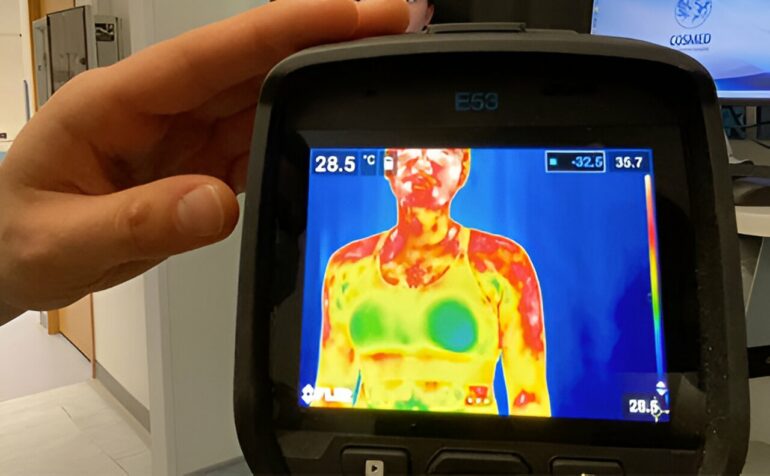A study by the University of Southampton has revealed a surprising link between breast size and the amount of sweat produced by the breast during exercise.
The study looked at 22 women of different ages and breast sizes while they ran in a warm climatic chamber—measuring how much sweat they produced across the breast, how much heat their bodies were producing and how many sweat glands they had on different parts of their breasts.
The study is published in the journal Experimental Physiology.
Sweat production is primarily influenced by factors such as body size, metabolism, and environmental conditions. However, the research team hypothesized that breast size could also impact both sweat production across the breast and comfort during physical activities.
The research, conducted by Hannah Blount—a postgraduate researcher in thermal physiology at the University’s ThermosenseLab—has found that bigger breasts have fewer sweat glands, meaning they produce less sweat when working out.
She said, “Over 85% of women deem a sports bra an essential piece of equipment for exercise, but it’s actually really hard to find one that’s comfortable and supportive, so a lot of women struggle with this. Our thought process was to look at how sports bras offer support to women and comfort to women of varying breast sizes, especially in hot conditions, when women are more likely to experience issues like chafing and significant sweat accumulation in the bra.
“Specifically, we were interested in understanding how sweat gland densities and local sweat rates change across women of different breast sizes, as that determines how much sweat ends up in the sports bra. Here we got the most exciting finding, as our results indicated that larger-breasted women presented fewer sweat glands, and so they produced less sweat across their breast. This fundamental knowledge is something we can now use to inform sportswear design that considers the needs of women of varying breast sizes.”
The experiments were conducted in the state-of-the-art climate chamber of ThermosenseLab, which is housed within the NIHR (National Institute for Health and Care Research) Southampton Clinical Research Facility, at University Hospital Southampton.
Women who took part were asked to jog for 45 minutes in 32-degree Celsius heat, while their sweat output at the breast was monitored. 3D scanning was used to calculate breast surface area, while sweat gland density was measured using iodine-infused paper which, when placed on the skin, reacts with the chemicals in sweat.
Dr. Davide Filingeri, Associate Professor in Thermal Physiology and internationally leading expert in the neurophysiology of human skin wetness sensing, said, “Women are a group of individuals that undergo unique anatomical, physiological and hormonal changes across their lifespan. Consider the impact of the menstrual cycle, pregnancy and menopause, all of which impact a woman’s heat tolerance, thermal sensitivity and comfort. As such, Hannah’s research on the unique and evolving ‘thermal needs’ of women’s bodies has the potential to inform person-centered innovation in sportswear, which will ultimately help women thrive in our warming climate.”
Blount added, “We’re becoming more sedentary as a society, so if we can do anything to aid women to become more active while making sport more accessible, then that’s really exciting.”
More information:
Hannah Blount et al, The effect of female breast surface area on heat‐activated sweat gland density and output, Experimental Physiology (2024). DOI: 10.1113/EP091850
Provided by
University of Southampton
Citation:
Your bra size is affecting how much you sweat, and it’s not what you’d think (2024, June 17)


